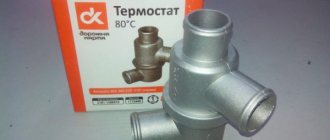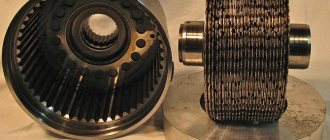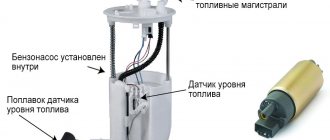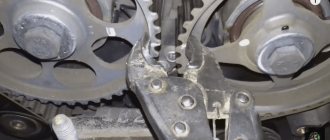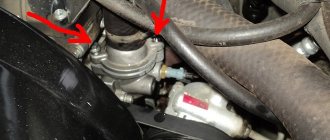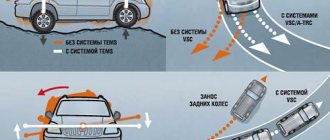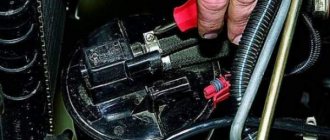Purpose and design features of the thermostat
The thermostat is designed to block the circulation of fluid through the cooling system until the car engine is completely warmed up in order to speed up this process and further maintain the required operating temperature.
Thermostat operating principle
is based on the melting of artificial wax placed in a small cylinder in the direction of the motor. Wax melts at a temperature of at least 80 degrees. At the same time, it expands, increasing in volume, due to which it squeezes the locking pin out of the cylinder, unlocking the thermostat valve and restoring circulation.
In general, a thermostat consists of:
- inlet pipe connected to the engine cooling system;
- bypass valve, which, if necessary, shuts off the small cooling circle;
- an outlet pipe connected to the coolant pump;
- spring holding the bypass valve;
- wax ball;
- inlet pipe connected to the radiator;
- springs holding the main valve;
- the main valve itself, designed to shut off the main circulation;
- piston;
- housings.
Before the engine warms up, the circulation of the coolant does not stop completely - it is carried out in a so-called small circle, where the coolant flows from the pump only through the cooling jacket and the heater radiator, so that the system does not stagnate. When the main circulation valve opens, the small circle is automatically closed.
That is, the entire thermostat device is actually just a cylinder, a return pin, wax and a number of minor parts. This simple thermostat circuit is effective and reliable, so it remains the same in most newer cars.
In different car models, thermostats are set to different opening temperatures, which are most often indicated on the device body. In addition, different cars can be installed with or without housing thermostats. Their main difference is the installation itself, either in the engine block, or in a separate housing, which is a complex two-level circuit.
Design and principle of operation
The design and operating principle of the thermostat largely depends on the type of filler.
Let's consider each of the options:
1. Thermostat with liquid filler.
Such devices have not been in nature for a long time (domestic ones since 1983), but still, for the sake of familiarization, we will touch on this topic.
A product based on a brass cylinder. Inside the latter there is a liquid that consists of distilled water and essential alcohol.
The cylinder is fastened to a special rod, and a special valve is welded to the second edge.
The latter rests on the saddle and is fixed in the device casing. There are four windows in the housing that allow fluid to flow from the cooling jacket to the pump even when the valve is closed.
The operating principle of a thermostat with a liquid filler is as follows.
At the moment of starting the power unit, the valve is pressed against the seat, thanks to the elastic structure of the corrugated cylinder.
As a result, access to the main radiator is blocked and the coolant does not flow in a large circle.
Through special windows, the liquid enters the pump, and then returns to the system jacket.
This principle allows the coolant to quickly reach operating temperature.
As soon as the level of the latter reaches 67-70 degrees, the liquid boils in the thermostat system and the pressure increases.
The corrugated cylinder expands and puts pressure on the rod. At the same time, the valve opens and the windows through which the liquid enters the pump are closed.
Next, the coolant is directed through the valve to the main radiator tank, distributed through its tubes and at the same time cooled to a safe temperature.
Afterwards, the cooled liquid is returned to the pump and into the general system. The cycle repeats.
2. Thermostat with solid filler.
Always installed on domestic and imported cars and trucks.
The device is based on ceresin (special wax), which is mixed with copper powder and installed in a special cylinder (made of brass or copper).
A membrane made of rubber is installed between the lid and the cylinder. The rod (also rubber) rests against the latter.
At the top, the cylinder is combined with a valve, which rests on the seat. A spring is mounted under the valve, which rests against a horseshoe-shaped guide connected to the body (flange) and holds the valve in the closed position.
During the operation of the power unit and heating of the coolant, the cylinder warms up and the temperature of the wax inside increases.
When the wax warms up to 65-70
degrees Celsius, the process of melting and its increase in volume begins.
As a result, the composition acts on the membrane, and the latter, through a special rod, acts on the valve, opening it. Thanks to this, the heated liquid enters the radiator.
The valve opens at a temperature of 78-82 °C. In general, the valve opening start temperatures for different engines and operating conditions range from 70 to 92 °C with a tolerance of ±2 °C.
If the temperature drops to a level 65-67
degrees Celsius, the reverse process of wax transformation occurs - it becomes hard and decreases in volume.
As a result, the spring expands and blocks the passage in the thermostat (the liquid is directed in a smaller circle). Next, the coolant goes to the pump and again into the cooling system.
Causes of thermostat failure
The most important sign of a thermostat failure is a lack of circulation in the engine cooling system, which leads to overheating.
There can be many reasons why a thermostat may malfunction, but the most common problem is corrosion eating away at the cylinder and locking pin, causing fluid flow to not completely stop in any valve position.
In such a situation, it will be much more difficult for the engine to warm up, and it will take much longer than in normal mode. If, on the contrary, the thermostat constantly remains closed, the engine quickly overheats, which leads to a complete inability to continue driving or more serious consequences, such as thermal deformation of the cylinder block and expensive engine overhauls.
When the coolant temperature indicator is on the verge of overheating, despite the fact that one hose is hot and the other is cold, we can most likely say that the thermostat valve is stuck closed and the liquid is not passing through the radiator.
Replacing the car engine thermostat
Replacing the thermostat incorrectly can lead to problems with the cooling system. Let's consider not only how to change a thermal valve with your own hands, but also how to correct the consequences of unsuccessful repairs. Often, due to the formation of an air lock after replacing the thermostat, the stove stops heating and the engine overheats.
Determining the functionality of the thermostat
In order to determine whether a given part works, you don’t even need to know where the thermostat is located. It is enough to simply warm up the engine, but do not bring its temperature to the red line. Then turn off the engine and open the hood, look for the upper and lower radiator hoses there. Simply touching them is enough. If one hose turns out to be hot, while the other remains cold, most likely the thermostat valve did not open when the engine was running, which means it is not operational and needs urgent replacement. The thermostat circuit is quite simple, the device is cheap, so there is no point in trying to repair it - changing it is much easier.
How to change a thermostat - instructions
The principle of operation of the thermostat is simple: when the engine heats up, the coolant begins to move along a wider circuit. This promotes stable operation of the motor and allows you to quickly bring it into working position. The problem is easy to notice: in modern cars it is signaled by an error, in older cars the engine temperature rises too quickly.
You need to change the thermostat yourself urgently if the unit does not work at all. The warmer it is outside, the higher the chance of the engine seizing. As a rule, complete failure is rare - more often we are talking about incorrect operation of the unit. But jamming in a half-open position is also harmful - the engine will take longer to warm up and fuel consumption will increase.
Node selection
How to change a thermostat correctly? First you need to buy a suitable unit. The easiest way to find a thermostat by car make is on large sites like ZAPCHASTI.RIA.COM, where there is a comprehensive selection of parts. The most important nuance is that it must operate at the temperature recommended by the machine manufacturer. We do not recommend purchasing a used ear unit or a product without packaging, since the working condition of the spare part is vitally important.
Replacement
For example, let’s take the popular Passat B5 car in Ukraine. In different trade winds, depending on the type of engine, the necessary unit is located slightly differently. In addition to the new thermostat, you also need to buy two new 6-bolts, since the old ones have already “worked out”.
Sequence of operations:
- Remove the terminals from the battery. A small precaution - let you be calmer.
- Remove the cap from the expansion tank (with antifreeze). This will relieve pressure in the system.
- Determine the location of the vehicle. Depending on the motor type, it can be accessed either from above (AWM/AWT) or from below (APU).
- Remove the engine protection. It is better to work from below, and to do this you will have to remove the cover (if there is one).
- Remove the pipe from the throttle valve. The clamps (if any) need to be carefully unscrewed - they will come in handy after a while.
- Remove the throttle valve. When thinking about how to properly change the thermostat, use a 5mm hex (you need to remove 4 bolts).
- Remove the metal spacer. It “hangs” on two bolts, one of which needs to be removed and the second needs to be loosened.
- Drain the antifreeze in a convenient way. Alas, after all the procedures it will have to be replaced with a new one.
- Rotate 90 degrees and remove the thermostat. It is located just behind the throttle valve. For the APU engine, similar manipulations can be performed from the bottom of the car.
- Wipe or clean the seat. For greater tightness, it is worth removing slag and debris that has formed along the radius of the nest.
- Installing the thermostat and assembling the car. In reverse order, you need to perform the same manipulations.
After the work is completed, you need to pour antifreeze into the system and make sure there are no leaks. As a result of the manipulations, the system will be aired for some time - this is not scary. The correct operation of the new unit can only be checked during operation.
Correct thermostat replacement: algorithm of actions
A properly functioning thermostat will not allow the engine temperature to go beyond its operating range. If problems arise with the valve, the motor begins to wear out at an accelerated rate. There is no point in repairing the thermostat, since its design, although simple, is not easily repairable. The price of the product is low, so if the device breaks down, a replacement is recommended, which is easy to do with your own hands.
